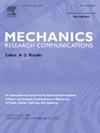二自由度方形和一自由度圆形结构串联的涡激振动
IF 2.3
4区 工程技术
Q3 MECHANICS
引用次数: 0
摘要
本文研究了由两个自由度(2DOF)的上游方形圆柱体和一个自由度(1DOF)的下游圆形圆柱体组成的串联结构的涡激振动。在雷诺数为1000 ~ 6500、降速为2 ~ 11、间距比(L/D)分别为3、6和9的条件下,采用分离涡模拟-剪切应力输移(DES-SST)模型进行了数值模拟。该研究考察了间距比对流体动力系数、振荡幅度、频率比、旋涡脱落行为和锁紧现象的影响。结果表明,间距比显著影响涡激振动动力学,较小的L/D比产生更窄的锁紧区域和增强的屏蔽效应,从而降低下游筒体的振动幅值和阻力系数。本研究观测到的下游结构在L/D = 6时最大位移幅值达到1D。上游方柱体振荡幅度较小,横向振幅随间距比增大而减小。这些发现为串联结构的动力学提供了重要的见解,有助于改进海上系统在涡激振动下的设计和操作。本文章由计算机程序翻译,如有差异,请以英文原文为准。

VIV of 2DOF square and 1DOF circular structures in tandem
This study investigates the vortex-induced vibration (VIV) of a tandem configuration consisting of a two-degree-of-freedom (2DOF) upstream square cylinder and a one-degree-of-freedom (1DOF) downstream circular cylinder. Numerical simulations are conducted using the Detached Eddy Simulation-Shear Stress Transport (DES-SST) model at Reynolds numbers ranging from 1000 to 6500 and reduced velocities between 2 and 11, with spacing ratios (L/D) of 3, 6, and 9. The study examines the effects of spacing ratios on hydrodynamic coefficients, oscillation amplitudes, frequency ratios, vortex shedding behavior, and the lock-in phenomenon. Results reveal that the spacing ratio significantly influences VIV dynamics, with smaller L/D ratios producing narrower lock-in regions and enhanced shielding effects, which lead to reduced vibration amplitudes and drag coefficients for the downstream cylinder. The maximum displacement amplitude observed in this study reaches 1D at L/D = 6 for the downstream structure. The upstream square cylinder exhibits relatively small oscillations, with a decrease in transverse amplitude as the spacing ratio increases. These findings provide critical insights into the dynamics of tandem structures, contributing to the improved design and operation of offshore systems subjected to VIV.
求助全文
通过发布文献求助,成功后即可免费获取论文全文。
去求助
来源期刊
CiteScore
4.10
自引率
4.20%
发文量
114
审稿时长
9 months
期刊介绍:
Mechanics Research Communications publishes, as rapidly as possible, peer-reviewed manuscripts of high standards but restricted length. It aims to provide:
• a fast means of communication
• an exchange of ideas among workers in mechanics
• an effective method of bringing new results quickly to the public
• an informal vehicle for the discussion
• of ideas that may still be in the formative stages
The field of Mechanics will be understood to encompass the behavior of continua, fluids, solids, particles and their mixtures. Submissions must contain a strong, novel contribution to the field of mechanics, and ideally should be focused on current issues in the field involving theoretical, experimental and/or applied research, preferably within the broad expertise encompassed by the Board of Associate Editors. Deviations from these areas should be discussed in advance with the Editor-in-Chief.

 求助内容:
求助内容: 应助结果提醒方式:
应助结果提醒方式:


